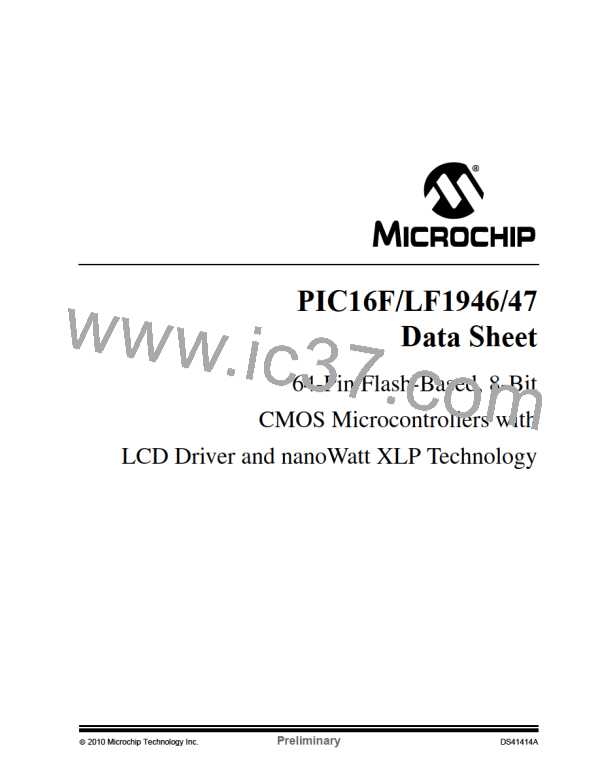PIC16F/LF1946/47
TABLE 29-16: I2C™ BUS DATA REQUIREMENTS
Param.
Symbol
Characteristic
Min.
Max. Units
Conditions
No.
SP100* THIGH
Clock high time
100 kHz mode
4.0
—
—
s
s
Device must operate at a
minimum of 1.5 MHz
400 kHz mode
0.6
Device must operate at a
minimum of 10 MHz
SSP module
1.5TCY
4.7
—
—
SP101* TLOW
Clock low time
100 kHz mode
s
s
Device must operate at a
minimum of 1.5 MHz
400 kHz mode
SSP module
1.3
—
Device must operate at a
minimum of 10 MHz
1.5TCY
—
—
SP102* TR
SP103* TF
SDA and SCL rise 100 kHz mode
time
1000
ns
ns
400 kHz mode
20 + 0.1CB 300
CB is specified to be from
10-400 pF
SDA and SCL fall
time
100 kHz mode
400 kHz mode
—
250
ns
ns
20 + 0.1CB 250
CB is specified to be from
10-400 pF
SP106* THD:DAT Data input hold time 100 kHz mode
400 kHz mode
0
—
0.9
—
ns
s
ns
ns
ns
ns
s
s
0
SP107* TSU:DAT Data input setup
time
100 kHz mode
400 kHz mode
100 kHz mode
400 kHz mode
100 kHz mode
400 kHz mode
250
100
—
(Note 2)
(Note 1)
—
SP109* TAA
Output valid from
clock
3500
—
—
SP110* TBUF
Bus free time
4.7
1.3
—
Time the bus must be free
before a new transmission
can start
—
SP111 CB
Bus capacitive loading
—
400
pF
*
These parameters are characterized but not tested.
Note 1: As a transmitter, the device must provide this internal minimum delay time to bridge the undefined region
(min. 300 ns) of the falling edge of SCL to avoid unintended generation of Start or Stop conditions.
2: A Fast mode (400 kHz) I2C™ bus device can be used in a Standard mode (100 kHz) I2C bus system, but
the requirement TSU:DAT 250 ns must then be met. This will automatically be the case if the device does
not stretch the low period of the SCL signal. If such a device does stretch the low period of the SCL signal,
it must output the next data bit to the SDA line TR max. + TSU:DAT = 1000 + 250 = 1250 ns (according to
the Standard mode I2C bus specification), before the SCL line is released.
2010 Microchip Technology Inc.
Preliminary
DS41414A-page 411

 MICROCHIP [ MICROCHIP ]
MICROCHIP [ MICROCHIP ]